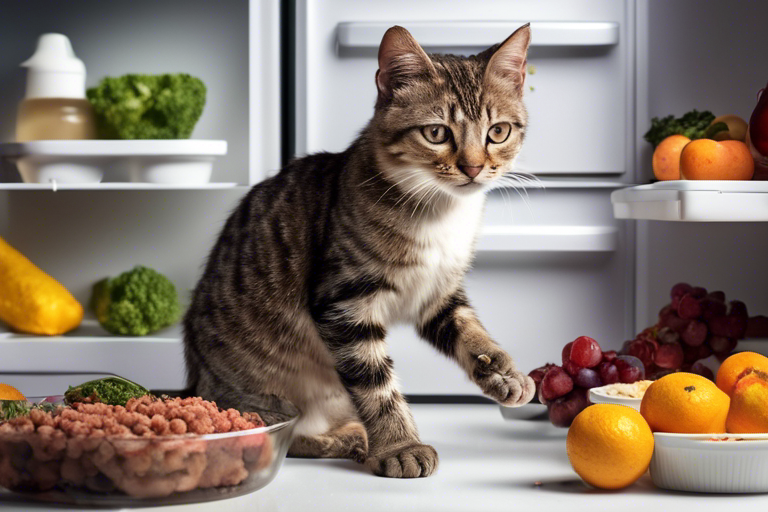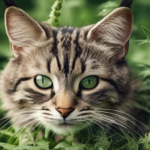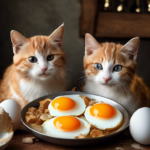Can Cats Eat from the Fridge? Exploring Safe and Nutritious Options in 2024
Cats are known for their discerning palates and specific dietary needs. As responsible cat owners, it’s essential to provide them with the proper nutrition they require. But what happens when you run out of cat food? Can cats eat from the fridge? In this comprehensive guide, we’ll explore the various human foods that cats can safely consume as emergency meals, ensuring they receive the sustenance they need.
Understanding a Cat’s Diet
Before we delve into the specifics of what cats can eat from the fridge, it’s important to understand their dietary requirements. Cats are obligate carnivores, meaning their bodies are designed to primarily thrive on meat-based diets. Unlike humans, they cannot obtain all the necessary nutrients from a solely plant-based diet. That’s why it’s crucial to provide them with high-quality cat food that meets their nutritional needs.
Safe Human Foods for Cats
Fortunately, there are several human foods commonly found in our fridges that can serve as suitable alternatives for cat food. With a little preparation, these foods can provide a temporary solution when you’re unable to access commercial cat food. Here are some human foods that cats can eat:
1. Meat
Cats can safely consume various types of meat, including beef, pork, chicken, and lamb. However, it’s important to ensure that the meat is unseasoned and properly cooked. Cooking the meat removes any harmful bacteria that may be present, making it safe for your cat to consume. Before serving, be sure to debone the meat, remove the skin, and trim any excess fat. This helps prevent potential choking hazards and ensures your cat receives the necessary nutrients without any added risks.
2. Fish
Fish is a popular choice among cats due to its taste and nutritional benefits. It contains omega-3 fatty acids, which promote a healthy coat and can help prevent kidney diseases and arthritis in cats. When offering fish to your feline friend, make sure it is deboned, skinned, and thoroughly cooked. Avoid feeding them tuna, as it is high in calories and mercury, which can be toxic to cats when consumed in large quantities.
3. Eggs
Eggs are surprisingly good for cats and can be a great source of necessary amino acids and proteins. To avoid the risk of salmonella, it’s important to cook the eggs before serving them to your cat. Boiled or scrambled eggs make for a simple and nutritious emergency meal option.
4. Grains
While cats are primarily carnivores, small portions of grains can be included in their diet as emergency replacements for cat food. Cooked smaller grains such as millet and couscous are easily digestible for cats. Oats and rice can also be viable options when you’re running low on cat food. However, it’s important to note that grains should not make up a significant portion of their regular diet.

5. Fruits and Vegetables
Cats are notorious for being picky eaters when it comes to fruits and vegetables. However, there are a select few that are safe for them to consume. Some cat-friendly vegetables include cucumber, carrots, steamed broccoli, asparagus, cooked spinach, and potatoes. When it comes to fruits, options such as bananas, blueberries, cantaloupe, watermelon, apples, and pumpkins are generally safe. Ensure that vegetables are cooked before serving, and fruits should be peeled and seedless to avoid any potential choking hazards.
It’s important to note that while these human foods can serve as temporary alternatives for cat food, they should not be relied upon as a long-term solution. Commercial cat food is specifically formulated to meet a cat’s unique nutritional needs, and these foods may not provide a complete and balanced diet. Therefore, it’s essential to consult with your veterinarian and transition back to regular cat food as soon as possible.
Considerations for Emergency Meals
While providing an emergency meal for your cat, there are a few important factors to consider. These include your cat’s age, any allergies they may have, and their specific dietary requirements. Different age groups of cats have varying dietary needs. Kittens and senior cats, for example, may require more frequent feeding with smaller meals. Adult cats, on the other hand, can typically be fed one to two meals a day. It’s crucial to tailor their feeding schedule based on their age and monitor their diet accordingly.
Allergies are also common among cats and can significantly impact their diets. Some cats may be sensitive to certain ingredients, which can lead to stomach discomfort, itching, and other symptoms. If your cat has known allergies or dietary restrictions, it’s important to avoid any foods that may trigger an allergic reaction. Consult with your veterinarian for guidance on suitable alternatives and potential dietary restrictions.
Tips for Making Cat Food in Emergencies
When you find yourself in a situation where you’ve run out of cat food, there are a few tips and tricks you can employ to create a homemade meal for your feline companion. These ideas can help you provide a temporary solution until you can restock on commercial cat food. Here are five tips on how to make cat food in emergencies:
- Chicken Liver and Heart Power Food: Chicken liver and heart are excellent sources of vitamins A and B, minerals, iron, and protein. Including these ingredients in your homemade cat food can provide essential nutrients.
- Vegetable Omelet: Combine eggs and vegetables of your choice to create a protein and fiber-packed meal that aids digestion. This simple dish can be made quickly and provides a nutritious option for your cat.
- Chicken Soup: Keeping your cat hydrated is crucial, and a simple chicken soup can help achieve that. Ensure the soup is low in sodium and salt to avoid any health issues.
- Bread: While not nutritionally rich, bread can be used as a filling meal in emergencies. Ensure it is consumed in moderation and does not replace a balanced diet.
- Spinach: Leafy green vegetables like spinach are packed with fiber and water, which can help keep your cat full and hydrated. They also contain essential omega-3 fatty acids, promoting overall health.
These tips can help you create makeshift meals for your cat during emergencies. However, it’s essential to remember that these should not become a regular part of their diet, as they may not provide all the necessary nutrients for long-term health.
Foods to Avoid
While there are several safe options for emergency cat meals, there are also certain foods that should be avoided. These foods can be harmful or even toxic to cats and should never be offered as a substitute for cat food. Here are some foods that cats cannot eat and why:
- Alcohol: Alcohol is highly toxic to cats and can lead to severe symptoms such as vomiting, diarrhea, and even coma or death if ingested in significant quantities.
- Chocolate: Chocolate contains methylxanthines that can cause increased body temperature, elevated heart rate, and body tremors in cats. It’s best to keep all chocolate products away from your feline friend.
- Dairy: While some cats enjoy milk, most become lactose intolerant as they grow older. Consuming dairy products can lead to stomach discomfort, diarrhea, and other digestive issues.
- Dog Food: While not inherently toxic, dog food does not provide the necessary nutrients that cats require. Cats need taurine, an essential amino acid found in cat food but not in sufficient quantities in dog food. Feeding cats dog food for an extended period can lead to health issues.
- Grapes and Raisins: Even a small amount of grapes or raisins can be toxic to cats and may cause kidney failure after 12 hours of ingestion. It’s crucial to seek veterinary assistance immediately if your cat consumes these fruits.
- Peanut Butter: While peanut butter may be a tasty treat for humans, it should be avoided for cats. Peanut butter can contain sodium, fats, and sweeteners that are not suitable for feline consumption.
- Xylitol: Xylitol, a natural sweetener found in candies and gum, can cause fatigue and potentially lead to liver failure in cats. It’s important to keep all xylitol-containing products away from cats.
By avoiding these foods and being mindful of potential hazards, you can ensure the safety and well-being of your feline companion.
Frequently Asked Questions
Q: What can I feed my cat if I don’t have cat food? A: In emergencies, you can provide your cat with cooked meat, fish, eggs, small grains, and select fruits and vegetables. However, it’s important to transition back to commercial cat food as soon as possible.
Q: Can cats eat refrigerated foods? A: Yes, cats can eat refrigerated foods as long as they are safe and suitable for their consumption. Properly cooked and stored refrigerated foods can be offered to cats in emergencies.
In Conclusion
While it’s important to provide your cat with a balanced and nutritionally complete diet, emergencies can arise where you find yourself without cat food. In such situations, it’s helpful to know what human foods can serve as temporary alternatives. Cooked meat, fish, eggs, small grains, and select fruits and vegetables can be offered to cats in emergencies. However, these foods should not replace their regular diet, and it’s important to consult with a veterinarian for guidance on proper nutrition. By being prepared and knowledgeable, you can ensure your feline friend’s well-being even in challenging circumstances.






